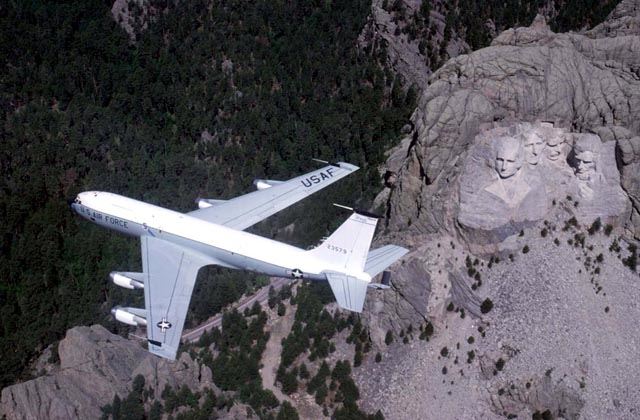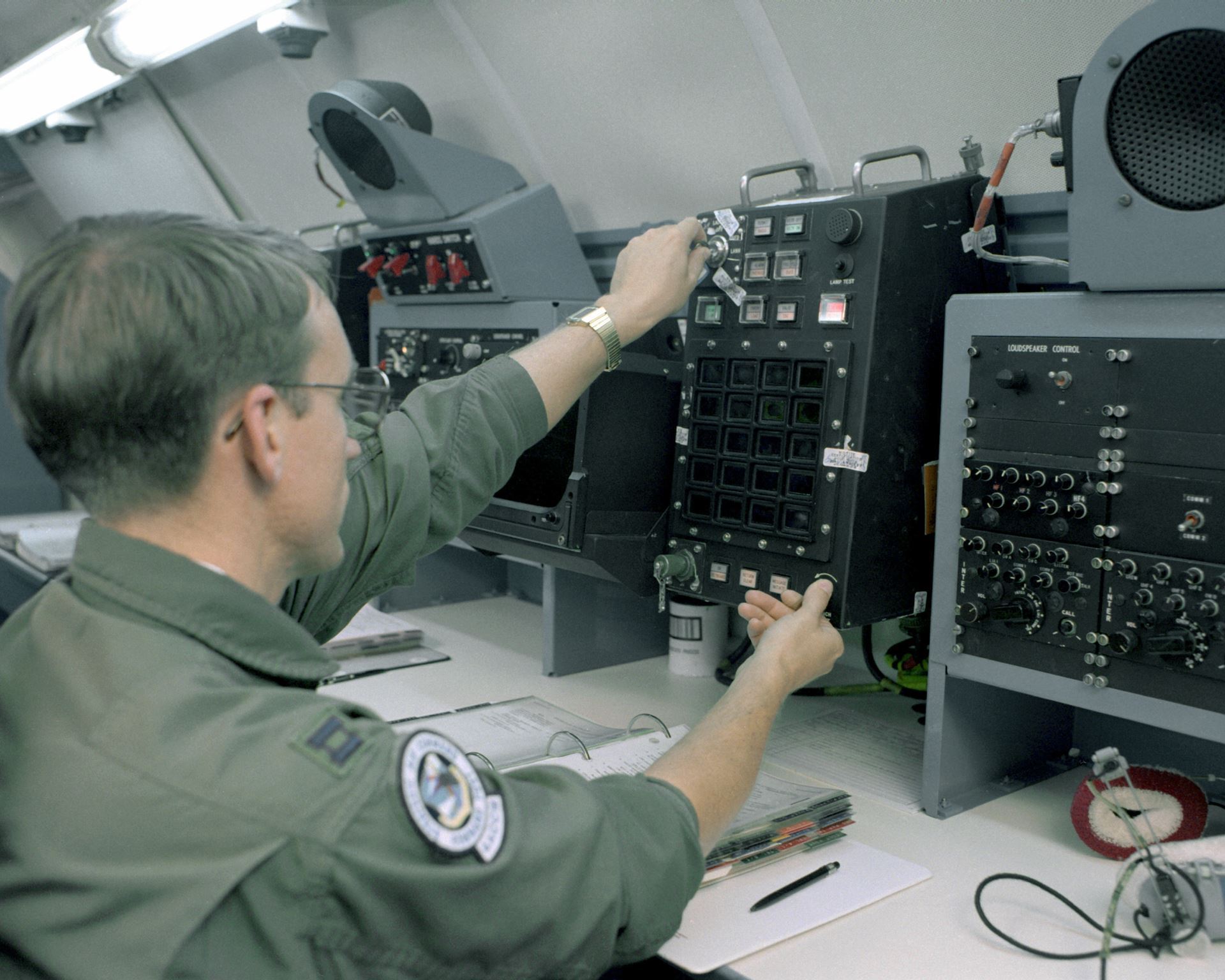Airborne Launch Control System (ALCS) Originally, the design concept was that a Soviet attack would not destroy all of the squadron launch control centers (LCC) and therefore launch of the Minuteman force was assured. As Soviet missile accuracy improved, however, it became clear that an LCC-only attack could make launch impossible unless retaliation was directed and implemented before LCC destruction. The airborne launch control system (ALCS) was developed in the early- to mid-1960s to counter this threat. The ALCS mission was provide an alternate retargeting and launch capability in the event of the incapacitation of the ground missile combat crews, destruction of the LCCs, or electrical isolation of the launch facilities (LF). It consists of equipment on specially equipped and crewed aircraft, and ultrahigh frequency (UHF) antennae and receivers at the LFs. It was part of the Strategic Air Command’s (SAC) Post Attack Command Control System (PACCS), but now exists only on the U. S. Strategic Command (STRATCOM) airborne command post. The aircraft, operated by the Navy, is the E-6B Mercury, which also flies the TACAMO (take charge and move out) mission of transmitting very low frequency (VLF) messages to the fleet ballistic missile submarines. Personnel of the 625th Strategic Operations Squadron at Offutt AFB now have the ALCS mission. ALCS, while not part of Minuteman as originally deployed, has been an integral part of the weapon system since ALCS’s development in the mid-1960s. The original ALCS crews were part of the 44th Strategic Missile Wing (SMW) at Ellsworth AFB, South Dakota, and the 91st SMW at Minot AFB, North Dakota. Fairly soon after the system became operational, the 4th Airborne Command Control Squadron (ACCS)stood up at Ellsworth as part of the 28th Bomb Wing (BW), and ALCS crews transferred to it. There were ALCS crews and equipment stationed at Ellsworth (4th ACCS) and at Offutt AFB, Nebraska (2nd ACCS). ALCS crews and aircraft from Ellsworth pulled alert there, with the 28th Air Refueling Squadron tanker crews (the West Auxiliary Command Post (WAUXCP)) crews pulled alert at the bomber alert pad), and at Minot, with Minot’s 5BW B-52 crews. The ALCS function at Offutt was aboard Looking Glass, the SAC Airborne Command Post. Although an EC-135C was on ground alert there as the Commander in Chief, SAC (CINCSAC)0 Support Aircraft, it did not have ALCS group B equipment (black boxes) aboard in that role. When that aircraft came off alert and returned to the Looking Glass rotation, the ALCS group B equipment was reinstalled. (The group A equipment - racks and wiring - stayed on the aircraft.) ALCS was a part of PACCS, which primarily provided airborne command control for SAC forces. The SAC Airborne Command Post (ABNCP, Looking Glass) anchored the system, with operating areas in the vicinity of Offutt and Whiteman AFB, Missouri (home of the 351st SMW, including the Emergency Rocket Communications System (ERCS). Heading east, the East Auxiliary Command Post was next in the chain, followed by Radio Relays 1 and 2, which linked PACCS to the National Military Command Center (NMCC), Alternate NMCC (ANMCC), and National Emergency Actions Command Post (NEACP). To the west were the WAUXCP and ALCCs 1, 2, and 3. A series of ground entry points gave PACCS the ability to access landline communications. An air-to-air-to-ground UHF link paralleled the primary alerting system and provided other voice communications. Collectively, PACCS could provide emergency action messages (EAM) to SAC bases and airborne aircraft by a number of communications systems. Looking Glass covered Whiteman (351st SMW). It was the only sortie on continuous airborne alert. ALCC-1 covered Ellsworth (44th SMW) and Warren (90th SMW). It and the WAUXCP, which was also ALCS-capable as the system spare, pulled ground alert at Ellsworth. ALCC-2 covered Malmstrom (341st SMW). ALCC-3 covered Minot (91st SMW) and Grand Forks (321st SMW. ALCC-2 and -3 pulled ground alert at Minot, but were based at Ellsworth. The EAUXCP and radio relays were based at Grissom AFB, Indiana; none had ALCS capability. When 3rd ACCS at Grissom deactivated, the EAUXCP aircraft and some of their aircrew, battle staff, and comm personnel moved to 2nd ACCS. Thereafter the EAUXCP had ALCS capability available but was not primarily responsible for any missile wing. ALCS equipment, during the SAC years, was installed in EC-135A, C, G, and L aircraft, and briefly, in the early 1980s, on the E-4B NEACP while SAC conducted operational testing to determine the feasibility of the E-4B as a replacement SAC ABNCP aircraft. All models of the EC-135 had at least three compartments aft of the cockpit. Compartment 1 held most of the radios, most of the ALCS equipment, and the switchboard. Compartment 2 held the radio operators (RO) and radio maintenance (RM) technicians, with all their associated control and diagnostic equipment. The ROs set up the UHF radios for ALCC data transmission, and also relayed EAMs. The RMs were the unsung heroes of PACCS: with their airborne performance monitors and soldering irons, they worked magic to keep the equipment operating (or to return it to operation), thus greatly enhancing PACCS and ALCS reliability. Compartment 3 held the missile combat crew-airborne (MCC-A) or battle staff, depending on the mission. Behind compartment 3 on the C-models were the galley, rest area, and head. On the As and Gs that area held the auxiliary power unit, an electrical generator powered by a small, hot, and very loud turbine engine. All 135s had air refueling capability, like any standard KC-135; they also could receive fuel. (This gave PACCS a great deal of flexibility, since the ABNCP battle staff could direct air refueling without stealing a bomber’s mated tanker. The dedicated ALCS aircraft were the A and G models. Based on a series of articles in the June and September 2004 AAFM Quarterly Newsleeter by Lt Col ()ret) Joh McLean and others. Photos - ALCS Aircraft over Mt Rushmore, ALCS position on aircraft, 4th ACCS ALCS Officers |
|



